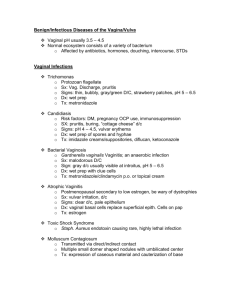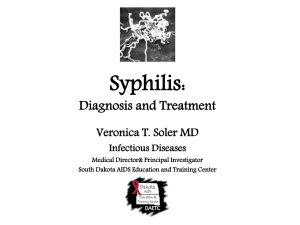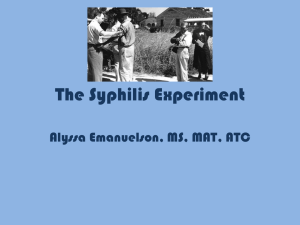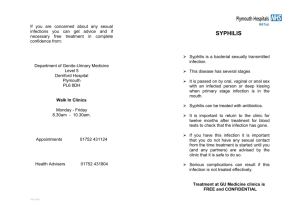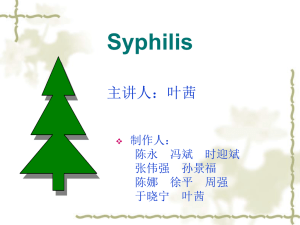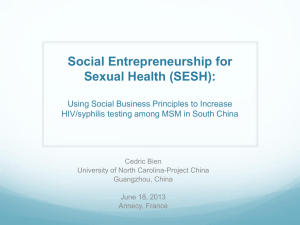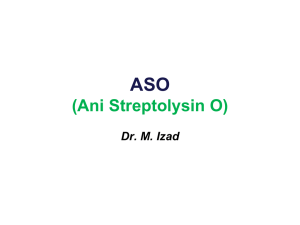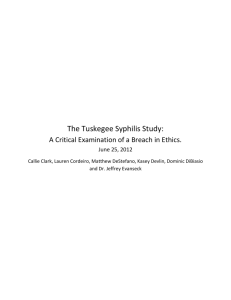Use for any document that isn`t a letter, report, memo, etc.
advertisement
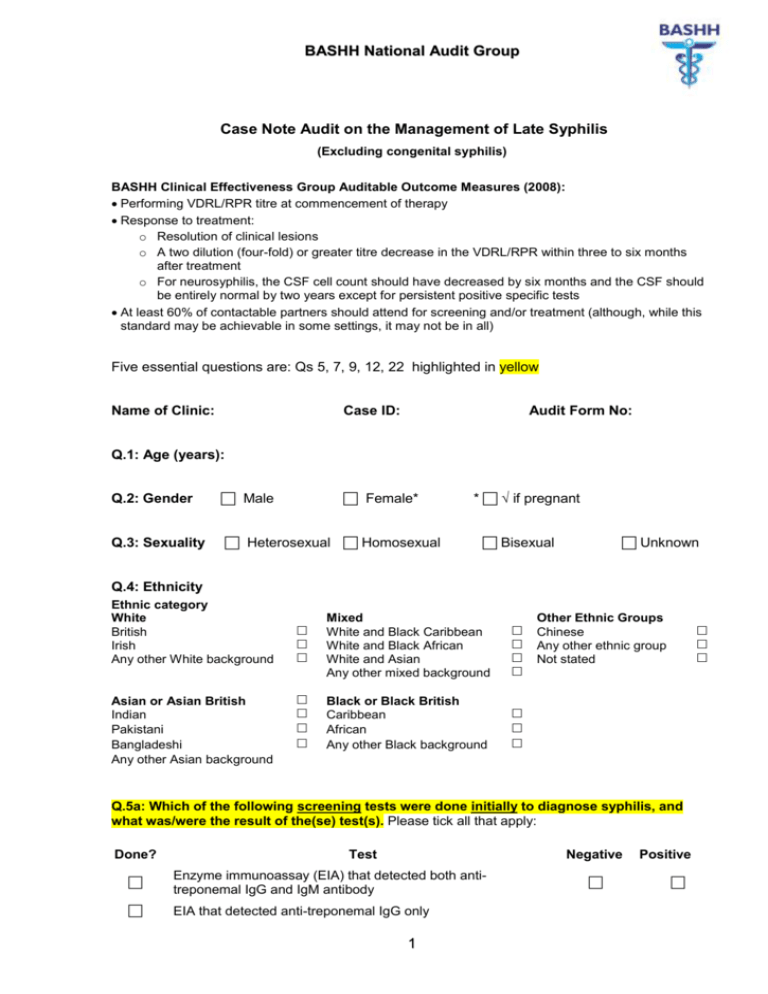
BASHH National Audit Group Case Note Audit on the Management of Late Syphilis (Excluding congenital syphilis) BASHH Clinical Effectiveness Group Auditable Outcome Measures (2008): Performing VDRL/RPR titre at commencement of therapy Response to treatment: o Resolution of clinical lesions o A two dilution (four-fold) or greater titre decrease in the VDRL/RPR within three to six months after treatment o For neurosyphilis, the CSF cell count should have decreased by six months and the CSF should be entirely normal by two years except for persistent positive specific tests At least 60% of contactable partners should attend for screening and/or treatment (although, while this standard may be achievable in some settings, it may not be in all) Five essential questions are: Qs 5, 7, 9, 12, 22 highlighted in yellow Name of Clinic: Case ID: Audit Form No: Q.1: Age (years): Q.2: Gender Male Female* Q.3: Sexuality Heterosexual Homosexual * √ if pregnant Bisexual Unknown Q.4: Ethnicity Ethnic category White British Irish Any other White background Asian or Asian British Indian Pakistani Bangladeshi Any other Asian background Mixed White and Black Caribbean White and Black African White and Asian Any other mixed background Black or Black British Caribbean African Any other Black background Other Ethnic Groups Chinese Any other ethnic group Not stated Q.5a: Which of the following screening tests were done initially to diagnose syphilis, and what was/were the result of the(se) test(s). Please tick all that apply: Done? Test Negative Enzyme immunoassay (EIA) that detected both antitreponemal IgG and IgM antibody EIA that detected anti-treponemal IgG only 1 Positive BASHH National Audit Group Treponema pallidum particle agglutination assay (TPPA) Treponema pallidum haemagglutination assay (TPHA) Venereal Diseases Research Laboratory (VDRL) Rapid plasma regain test (RPR) Other, please specify: Q.5b: Which of the following test were done to confirm the diagnosis of syphilis, and what was/were the result of the(se) test(s). Please tick all that apply: Done? Test Negative Positive Repeating testing on a second blood sample Treponema pallidum particle agglutination assay (TPPA) Treponema pallidum haemagglutination assay (TPHA) Venereal Diseases Research Laboratory (VDRL) Rapid plasma regain test (RPR) Antitreponemal IgM antibody Treponemal IgG immunoblot using recombinant antigen Fluorescent treponemal antibody absorption test (FTA) Direct fluorescent antibody (DFA) Other, please specify: Q.5c: Which of the following additional tests were done to support a diagnosis of late syphilis, and what was/were the result of the(se) test(s)? Please tick all that apply: Done? Test Negative Positive Tissue biopsy Other, please specify: Q.6: Please state any presenting clinical features Symptomatic. Please state which symptoms were present: Asymptomatic Clinical signs of syphilis found. Please state which clinical signs of syphilis (including any neurological or cardiovascular system signs attributed to syphilis) were found: No clinical signs of syphilis found Past history of treatment for syphilis Obstetric history of miscarriages or stillbirths Other, please state: Q.7a: Which of the following were offered and provided to this patient? 2 BASHH National Audit Group Please tick all that apply: Offered Provided Mouth examination Skin examination Perianal skin examination Lymph node location examination Cardiovascular system examination Neurological examination Optic fundus examination Lumbar puncture and CSF examination Electrocardiogram Chest X-Ray Other, please specify: Q.7b: If CSF examination was carried out, please state the findings here: Q.8: What stage of syphilis infection did this patient have? Late latent syphilis Cardiovascular syphilis Gummatous syphilis Other, please specify: Neurosyphilis Q.9: Was the patient offered an HIV test during this episode? Please tick all that apply: Known HIV positive Offered HIV test, result positive Offered HIV test, result negative Not offered HIV test Offered HIV test, declined A plan for repeat HIV testing was documented Other, please specify: Q.10: Was the patient offered screening tests for other sexually transmitted infections (STIs) during this episode? Offered, declined Not offered Offered, result(s) negative Offered, result(s) positive. Please state diagnostic codes of infections detected: Other, please specify: Q.11a: If female, was a pregnancy test offered? Yes No Not documented/known Not applicable Q.11b: If Yes, please state the result of the pregnancy test: 3 BASHH National Audit Group Q12a: Please specify which of the following drug treatments was given for late syphilis. Please tick all that apply (if more than one treatment was given, please explain the circumstances under Other): Benzathine penicillin 2.4 MU intramuscularly weekly for two weeks (three doses) Procaine penicillin 600,000 units intramuscularly once daily for seventeen days Procaine penicillin 1.8–2.4 MU i.m. once daily plus probenecid 500 mg orally four times daily for seventeen days Doxycycline 100 mg orally twice daily for twenty-eight days Doxycycline 200 mg orally twice daily for twenty-eight days Amoxycillin 2 grams orally three times daily plus probenecid 500 mg four times daily, both for twenty-eight days Benzylpenicillin 18–24 MU daily, given as 3–4 MU intravenously every four hours for seventeen days Long acting Biclinocillin IM 2 MU (containing benethamine penicillin 1.2 MU Long-acting procaine penicillin G in aluminium stearate (Jencillin O) 2 MU Other, please specify: Q12b: Was the treatment given under direct observation by clinic staff? Yes No Not documented/known Q.13: If the patient was penicillin-allergic, was penicillin desensitization offered? Yes, declined Yes, accepted Not offered Not penicillin-allergic Other, please state: Q.14: Was a discussion with the patient about possible adverse reactions to treatment documented? Yes No Not documented/known Q.15a: Did the patient have any adverse reaction to treatment for syphilis? Yes No Not documented/known Q.15b: If Yes, please give details of the reaction and the treatment given: Q.16a: Was a corticosteroid course prescribed? Yes No Q.16b: If Yes, please state why this was prescribed: Q.17a: Was the patient offered specific follow up for syphilis treatment? Please tick all that apply: No follow up was offered Offered follow up, but declined 4 BASHH National Audit Group Offered follow up, accepted Option of review left to patient choice A follow up plan was documented Other, please specify: Q.17b: If a follow up plan was documented, please specify the follow-up intervals documented, beginning from treatment completion. Please tick all that apply: 3 monthly until serofast* Other, please state below: *serofast means there was no change in the VDRL/RPR titer with repeated testing during follow up. Q.18a: On how many occasions did the patient attend a genitourinary medicine clinic for follow up after completion of treatment for syphilis? Please state the number of follow visits: The patient did not attend for any follow up visits at this clinic The patient was followed up at another genitourinary medicine clinic Q.18b: If the patient did not attend any planned follow up visit at your clinic, was recall of the patient attempted on at least one occasion? Yes No Not documented/known Q.19: Did the patient complete the full course of treatment? Yes No Not documented/known Q.20a: Did any symptoms attributed to syphilis resolve? Yes No Not applicable Not documented/known Q.20b: If No, please state which symptoms remained: Q.20c: Did any clinical signs of syphilis resolve? Yes No Not applicable Not documented/known Q.20d: If No, please state which clinical signs remained: Q.21: Was the patient given a letter documenting his/her treatment? Yes No Not documented/known Q.22a: What was the serological outcome for this patient following treatment for syphilis? Please tick all that apply: Negative pre-treatment VDRL/RPR which was also negative 3 months after treatment completed VDRL/RPR titre decreased by at least two dilution steps (fourfold) within the 3-6 months from treatment completion VDRL/RPR serofast between two tests taken three months apart 5 BASHH National Audit Group VDRL/RPR titre remained at greater than 1:8 with repeated follow up testing VDRL/RPR titre initially decreased by at least two dilution steps, but later increased by at least two dilution steps Other, please specify: Q.22b: What further diagnoses and/or action(s) followed this patient’s (initial) treatment for syphilis. Please tick all that apply: Reinfected diagnosed Treatment failure diagnosed Reactivation of syphilis diagnosed Patient retreated for syphilis Patient discharged from further follow up for this syphilis episode Annual follow up recommended for life Regular VDRL/RPR testing recommended beyond any follow up plan for syphilis for as long as at continued risk syphilis reinfection (Repeat) CSF examination carried out. Please state the reason for this and the findings: Other outcome, please specify: Q.23a: Was it documented that the patient was offered written information on syphilis? Yes No Q.23b: If Yes, did this include information on possible adverse reactions to treatment for syphilis? Yes No Q.24: Please provide any additional comments about the management of this patient in your clinic here: For case note questions on partner notification, please see the Case Notes Audit on Partner Notification Questionnaire: www.bashh.org/groups/national_audit_group Last modified 17 October 2012 Hugo McClean/Anatole Menon-Johansson Thank you for completing this questionnaire 6
